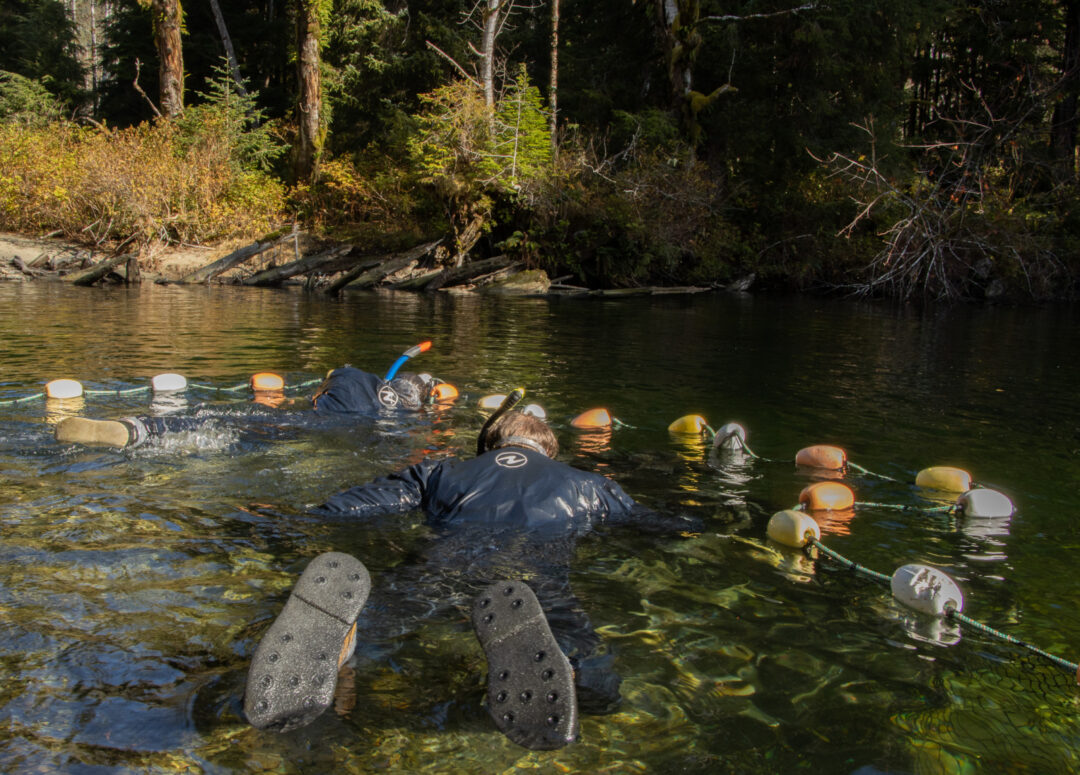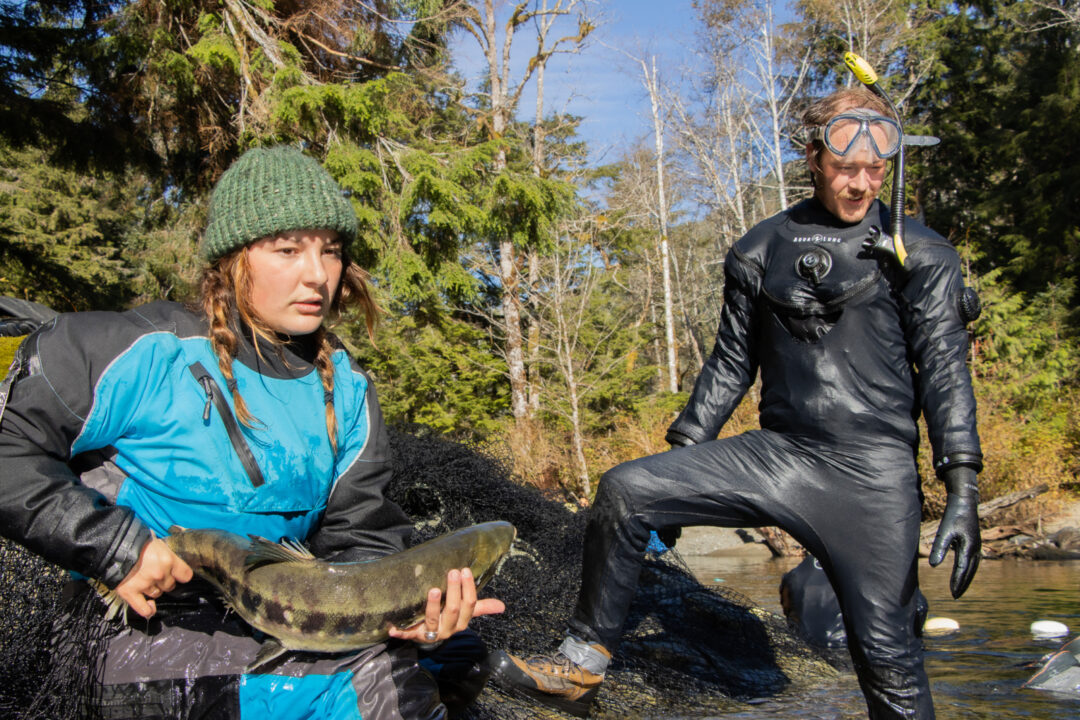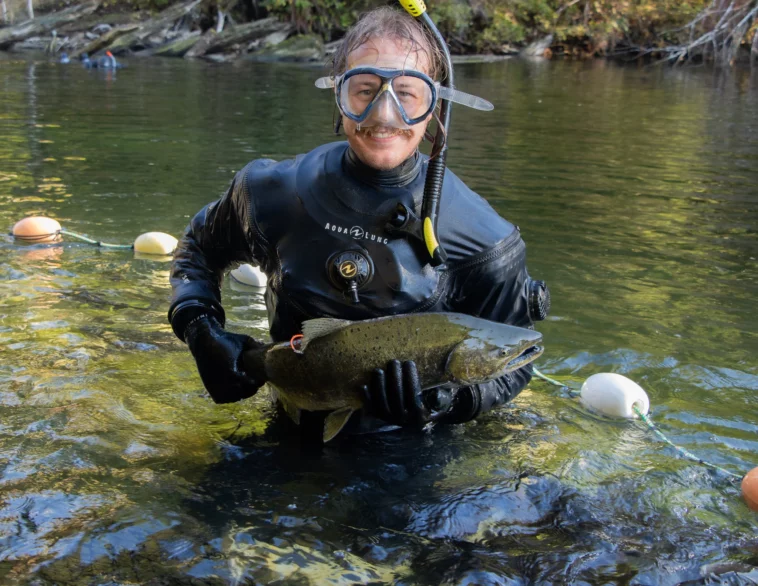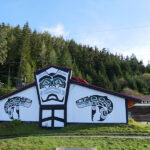By Marc Fawcett-Atkinson, Local Journalism Initiative reporter for the National Observer
On a rare sunny late October day, a quartet of swimmers gathered around a deep pool ready to immerse themselves in the frigid water with hundreds of huge salmon swimming upstream to spawn. Clad in full-body down outfits beneath heavy drysuits and snorkels, the group had made the nearly hour-and-a-half-long trip from Tofino, B.C., to HIŁSYAQƛIS/Tranquil Creek in Clayoquot Sound by boat and back roads to count salmon migrating up the frigid stream.

The effort is part of a years-long study that was recently adopted by the Ha’oom Fisheries Society, a Nuu-chah-nulth-led fisheries organization, to assess the health of the river’s chinook salmon stocks by tagging chinook with plastic bands. Tagging the fish helps researchers identify individual salmon that have been previously counted and tagged, giving them a more accurate estimate of how many chinook enter the river and how long they stay there, explained project leader Keaton McCallum.
“If we think the fish live for 14 days versus 21 days — two weeks versus three weeks — that can very quickly change how many fish we think are in that river,” he explained. Those data are key to estimating the population size, which informs the First Nations’ decisions about when — or whether — to allow fishing. They also give insights into the impacts of climate change and other environmental harms on the fish.
The study has run against a backdrop of efforts by the Nuu-chah-nulth and other First Nations across B.C. to wrest back conservation and fisheries management for wild salmon from Fisheries and Oceans Canada (DFO) after decades of policies designed to exclude them. The Nuu-chah-nulth have been at the centre of this push, becoming the first West Coast First Nations to establish their own commercial fisheries after a lengthy legal battle with the federal government.

Accurate fish population estimates “are key” to those fisheries’ success, said Mowachaht/Muchalaht lands and natural resources manager Roger Dunlop.
However, deriving accurate estimates is not easy. For years, DFO estimated salmon populations by inputting data collected by acoustic monitors and technicians’ fish counts into computer models. But Dunlop always doubted the numbers were accurate. In 2006, Dunlop, then a fisheries biologist with the Nuu-chah-nulth Tribal Council, started trialling the “mark-recapture” method used in the HIŁSYAQƛIS/Tranquil Creek project on another Vancouver Island river.
The population estimates generated by the project in its early years proved to be a more accurate representation of how many salmon were actually returning to spawn than the numbers cited by DFO. They are also more capable of estimating the impact of drought on salmon populations by integrating the date of the first big autumn rains into the population model, he explained. Researchers have warned that severe droughts are poised to become more common as the climate crisis deepens.
Climate models predict that B.C.’s oceans and rivers are poised to warm up even more in the coming decades. That will likely impact the survival rates of salmon, which depend on cool water and struggle when their waters are too warm.
“We’re gonzo,” Dunlop said. “The oceans are never going to cool off unless we get an asteroid strike, or maybe major volcanism in Iceland will do it.”
Despite dire predictions for the long-term future of salmon, the HIŁSYAQƛIS/Tranquil Creek salmon-counting crew had no trouble finding fish on this day. After a quick snack and final sip of hot coffee at the truck, the four-person team headed down a muddy bank to the river’s edge.
Then, with golden retriever enthusiasm, three of the drysuit-clad crew members jumped into the frigid, translucent green water. Looking more seal than human, they spent 15 minutes splashing their way upriver in an effort to scare salmon into the pool.
On shore, team leader Abigail Grigg sat in a dinghy waiting for the fish to flock in the pool so she could catch them in the seine, a type of fishing technique that envelopes fish in a large net, and lift them to the surface. Speed is the trick to a successful seine, she explained. Once the swimmers make their way into the pool, they don’t have much time before the salmon slip beyond the net’s reach.
Taking her cue from the swimmers in the pool, Grigg kicked the boat’s outboard into gear, steering a wide circle through the water. The net — one end tied to shore, the other to her dingy — trailed through the water in an arc. Reaching the shore once more, she hopped on a rocky outcrop and hauled the net in.
The water’s surface was soon boiling with fish. Dozens of coho salmon over a foot long pushed against the net, their skin marked with gashes and missing skin common to spawning salmon, which die after they spawn. A handful of chinook were mixed in the catch, their skin a shiny silver.
Without hesitation, Grigg and her co-workers jumped into the fray, grabbing the fish — many weighing several pounds — counting them and tossing them back into the river. The few untagged chinook that showed up in the net were brought ashore, measured in a tub of water and affixed with a numbered, colour-coded plastic tag identifying the fish as new arrivals.
Twenty minutes later, the net was empty and the team jumped back in to repeat the process — today would be a two-seine day, Grigg told me. An hour of splashing, boat manoeuvring and fish counting later, the crew gathered in the river for their final swim of the day. Tired and hungry after nearly two hours of swimming, it was time to enjoy a sunlit float downstream before the boat ride home.
This story by the National Observer is republished here under the terms of the Local Journalism Initiative.




